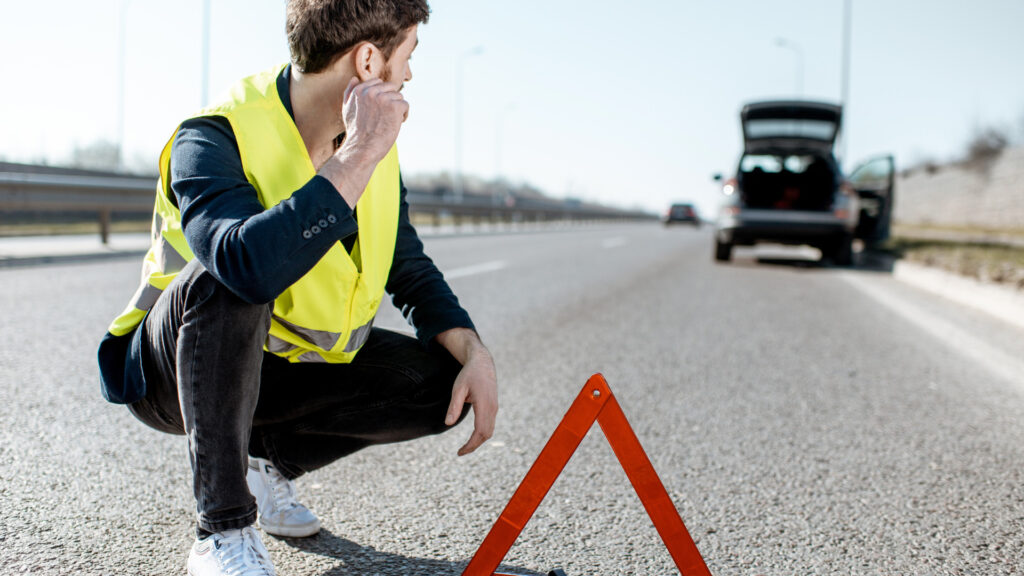Table of Contents Show
The RV community is typically a tight-knit group that’s friendly and helpful to one another.
They’ll come to the rescue, share tips and tricks, and selflessly offer their knowledge, experience, and resources. It’s common to see them lending a hand when a fellow camper struggles to get into a campsite or maneuver their rig through a campground.
Unfortunately, that wasn’t exactly the case recently for one traveler. In fact, their experience was the exact opposite. They watched as one RV after another ignored a very important law that was put in place to protect everyone on the road.
What law were they breaking, and how can you avoid the same? Let’s find out!
Some travel days don’t go exactly as planned. Trust us; we’re just like everybody else and have been on the receiving end of traffic jams, mechanical failures, and other issues.
However, Terry Wilgus posted about her and her husband’s stressful travel day, which would have caused many RVers to throw in the towel.
The couple experienced two tire blowouts on their fifth wheel. This left them stuck on the side of Interstate-65 just south of Birmingham, Alabama.
Unfortunately, if experiencing two blown tires wasn’t enough, fellow drivers practically kicked them while they were down by not slowing down or moving over to keep a safe distance.
Terry stated that many RVs “did not move over for us even when they were clear to do so safely.” She said she knew someone above was watching out for her and her husband in this stressful and dangerous situation.
“A little human kindness goes a long way,” Terry said. You never know when it could be you on the road that could use the extra space.
What Is the Move Over Law?
The Move Over law is a traffic safety law requiring drivers to change lanes when approaching an emergency or law enforcement vehicle on the side of the road. AAA estimates that 71% of Americans are unaware of Move Over laws.
All 50 states have laws requiring vehicles to switch lanes for emergency and law enforcement vehicles. This has been the situation since Hawaii became the 50th state to enact “Move Over” legislation in 2012.
However, as we’ll show you later, these laws vary from state to state regarding disabled, utility, and sanitation vehicles.
We’ll dive deeper into the potential punishments for violating these laws later. However, spoiler alert, you can expect serious fines and potentially spend time in jail in some states. So you likely want to familiarize yourself with these laws.
What Is the Purpose of Move Over Laws?
Move Over laws were created to protect the safety of emergency responders and law enforcement officers. These laws create safer conditions for responders working on the side or along the road. By increasing the distance between them and traffic, they have a lower risk of being hit by passing vehicles.
Unfortunately, AAA estimates that despite these laws, around 23 workers and first responders die each year, and hundreds receive severe injuries while helping disabled vehicles.
The National Highway Traffic Safety Administration highlights the dangers, as 47 law enforcement officers were killed in traffic-related incidents in 2017.
What Type of Vehicles Do Move Over Laws Cover?
As we mentioned, all 50 states have Move Over laws that cover law enforcement, emergency vehicles, and first responders. However, less than three-quarters of the states extend these laws to cover tow trucks.
Even fewer states have laws regarding protecting disabled vehicles stuck on the side of the road. Typically, Move Over laws only cover emergency personnel. Thankfully, we’re seeing and hearing more traction from states extending the laws to disabled vehicles.
For example, the Volunteer State of Tennessee requires drivers to move over for vehicles on the side of the road with their flashers on when it’s safe to do so. Unfortunately, not all states are as generous.
However, even if your state doesn’t enforce Move Over laws for disabled vehicles, you should follow the same principles for everyone’s safety.
What Are the Penalties for Violating Move Over Laws?
Like most driving laws, the penalties for violating Move Over laws vary by state. Most states hand out stiff fines or even points on the offender’s driving record. This typically results in increased insurance premiums or the requirement to attend traffic school.
If a hit to your wallet isn’t enough, some states take it further and require violators to serve their community for hours or days. Additionally, a driver could have their driver’s license suspended for up to 90 days.
Some states will sometimes hand out jail sentences from 30 to 90 days. Spending time in the slammer may open some people’s eyes to their dangerous behaviors.

What Should You Do When Stranded in a Vehicle?
If you find yourself stranded on the side of the road like Terry and her husband, you can do several things to maximize your safety. Will this guarantee your safety? Absolutely not.
However, it can help you stay as safe as possible until you can get back on the road.
Move to a Safe Location
If your vehicle becomes disabled while driving, move to a safe location as quickly and safely as possible. Moving out of the way will help to prevent further accidents or injuries and ensure that you and your passengers are not at risk from passing traffic.
If you can safely reach an exit ramp, emergency shoulder, or rest stop, do so. However, you’ll sometimes have no choice but to park on the side of a busy highway.
If so, ensure you get your entire vehicle off the roadway. You have a higher risk of getting struck by oncoming traffic the closer you are to the road.
Keep in Mind: Before you attempt to triple tow, do you know the laws in your state?
Use Hazard Lights and Be Visible
The first thing you should do during an emergency is to turn on your hazard lights. They alert other drivers that you are experiencing an issue and will increase your visibility.
We recommend carrying a roadside emergency kit for this very reason. Many of these kits include a warning triangle, reflective vest, and other essentials to keep you and your passengers safe.
You may carry your roadside emergency kit for thousands of miles and never need to use it. However, you’ll be glad you have it when you do. These compact and inexpensive pieces of equipment can save the day during an emergency. Even if you’re short on storage, it’s worth making room for one.
Stay in Your Vehicle
While jumping out of your vehicle and assessing the situation might be tempting, it’s typically not. By getting out of your car, you drastically increase the risk of getting struck by a passing vehicle.
Remain in your car and keep your seatbelt on. Your seatbelt will help keep you in your seat if a passing vehicle strikes you.
Call for Assistance
While remaining in your vehicle with your seatbelt fastened, grab your phone and call for assistance.
Depending on the situation, you may call 911 and ask an officer to come to the scene. They can come with their flashing lights, forcing traffic to slow down or move over.
If you subscribe to a roadside assistance service, this is the time to call them. However, don’t expect help to arrive quickly. Some travelers have had to wait several hours for someone to arrive.
If you are physically able to and have the tools, you likely will get back on the road faster if you can change the tire yourself. But only do so in a safe location away from traffic.
Pro Tip: So what roadside assistance services are worth subscribing to? Take a look at our top RV Roadside Assistance recommendations!

Be Aware of Your Surroundings
When stranded in a vehicle on the side of the road, remain aware of your surroundings. Take notice of landmarks, road signs, or any other identifiable features. This may be helpful for emergency services to locate you.
Additionally, you want to be aware of your surroundings, especially at night. That person pulling up to offer assistance may have ulterior motives and may not be as concerned about your safety as you might think.
Ultimately, your safety is the most important. If you do not feel comfortable accepting help or assistance from a stranger, you don’t have to accept it.
Stay Warm and Hydrated
You need to consider that you could be stuck on the side of the road for a considerable time. You must keep yourself and any of your passengers warm and hydrated. This may be harder at some times than others.
What you should carry with you during trips significantly depends on the weather. If traveling during the winter, have blankets and other cold-weather gear in your car.
If traveling during the summer, always have a case or jug of water on hand. You never know when these supplies will come in handy or save the day in a tough situation on the side of the road.
Always Follow Move Over Laws
While laws vary by state, being a decent human being is acceptable in all 50. Keep your distance as much as possible, whether in an emergency, utility, or passenger vehicle on the side of the road.
We’ve found ourselves on the shoulder and know that it can be very scary to try to fix an issue with cars whizzing by only a foot or two away. Do yourself and others on the road a favor and always follow Move Over laws.







I never realized there was an actual law but I always move over anyway because…duh. Why wouldn’t you move over if only out of possible self preservation.
While I’ve found that the majority of people are considerate and helpful, not everyone is as aware of what’s going on around them as they should be.